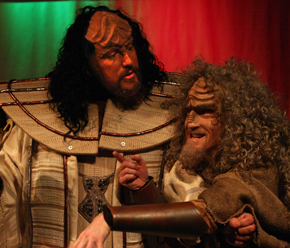
If you don't know what a Klingon is, any Star Trek enthusiast will be happy to acquaint you with this tribe of warriors recognizable by their distinctively scarred foreheads—a hereditary deformity tracing its source to a plague centuries earlier. As with such fantasy-epics as The Lord of the Rings or the Harry Potter series, the culture of the fictional worlds in which Klingons dwell has been analyzed extensively by its devotees, but not until 2007 did Commedia Beauregard, a Minnesota-based theatre company specializing in translated plays, propose an adaptation of Charles Dickens' classic holiday fable, A Christmas Carol, performed entirely in the artificial Klingon language.
A Klingon Christmas Carol presented challenges to its creators not only anthropological and linguistic (during performances, the English text is projected on screens above the stage for the benefit of exclusively terrestrial audiences), but visual as well. The Klingons depicted in the television series were generic starship crewmen in military dress, but Dickens' fable encompasses a wide diversity of ages, genders and personalities—from the crabbed SQuja' ("Scrooge") to his meek subordinate QachIt and the latter's sickly youngest son, tImHom. How do the actors convey the appearance of these various personae while encumbered by corrugated rubber patches glued to their brows?
Christopher Kidder-Mostrom helms the makeup duties for the now Chicago-based branch of the company, basing his execution on the original designs by Bill Hedrick for the original Minneapolis production.
"When you're dealing with prosthetic makeup," explains Kidder, "There are three fundamental options: foam latex allows the skin to breathe, but has to be replaced too often. Silicone is flexible, but it's expensive and, again, it doesn't last for long. That leaves poured latex, which is uncomfortably rigid and seals off the pores, but is sturdy enough to last the whole run."
What this means for the actors is that all facial expression from the eyes up no longer exists. "Our acting style for this show is based in body-oriented techniques like DelSarte or Michael Chekhov. Eventually, through rehearsal, we develop a physical vocabulary—somewhere along the lines of, 'When a Klingon does this, it means that'. We also rely on snarls, smiles and lots of mouth movement to convey the characters' emotions. They're not Vulcans, after all."
The problems don't end after the show opens, however. "The first actor who played SQuja' didn't know that he was allergic to latex until the show committed to a multi-week run." recalls Kidder, "Sweat also tends to pool up underneath the prosthetic patch and then trickle into the actors' eyes—some actors use sections of kotex underneath their headpieces to absorb the moisture, others apply the adhesive over a larger area to eliminate the spaces where it collects, and a few lucky ones apparently just don't perspire through their foreheads."
What do the actors, who must apply and remove the grotesque visages every night, have to say? Kevin Alves, who plays SQuja' in the current run, shrugs, "Lots of water, toweling off and powder to keep it all from dripping," while Christina Romano, who plays his childhood sweetheart Bel, confides, "The hardest part is acting without your eyebrows, because if you move your forehead, it loosens the headpiece. Even so, I only used two bottles of spirit gum to stick it on for last year's run—but a metric ton of cotton balls to clean the latex mask and my own face."
Commedia Beauregard's production of A Klingon Christmas Carol runs in the Raven Theatre's East Stage through December 30.
Mary Shen Barnidge
Contributing Writer

 Follow Us On Twitter
Follow Us On Twitter